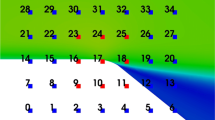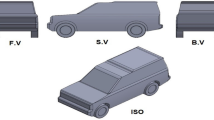Abstract
The aerodynamic understanding of the automobile has become very significant for the automotive industry to decrease fuel consumption. The aerodynamics of vehicles influences fuel consumption, stability, cooling, safety, and environmental pollution. As the shape of the vehicle plays an important role in automobile aerodynamics, it is desired to optimize it for better performance. For optimization, the simulations are run for the varying parameters of system design. Automobile aerodynamics depends on a large number of parameters. Even if some key parameters are selected, still there are very large numbers of aerodynamic parameters that need to be considered for which a smart optimization tool is required. A Fluent Adjoint solver has been used for aerodynamics optimization in this study. This tool directly identifies the most sensitive parameters and modifies the geometry to achieve desired changes in the observables, i.e., drag and lift. Additionally, it results in optimal design in a minimum number of simulations. In the current study, the aerodynamic investigation was performed for a commercial car, including shape optimization for reducing drag and increasing its stability (negative lift). The drag and lift coefficients of the car were computed using the ANSYS Fluent. After the conventional flow simulation, an Adjoint solver was used to determine its shape sensitivity concerning observables i.e., drag and lift. Based on that sensitivity data, the shape was modified using a mesh morphing operation. The modified car was again analyzed and a significant improvement was observed in its aerodynamics. There was a decrease of 0.02, about 6% in the drag coefficient, and an increase of 0.05, about 24% in the negative lift coefficient.

















Similar content being viewed by others
References
Mukut, A.N.; Abedin, M.Z.: Review on aerodynamic drag reduction of vehicles. Int. J. Eng. Mater. Manuf. 4(1), 1–14 (2019)
Sarkar, S.; Thummar, K.; Shah, N.; Vagrecha, V.: A review paper on aerodynamic drag reduction and CFD analysis of vehicles. In: Proc. A Rev. Paper Aerodyn. Drag Reduction CFD Anal. Vehicles, pp. 231–235 (2019)
Englar, R.J.: Development of pneumatic aerodynamic devices to improve the performance, economics, and safety of heavy vehicles (No. SAE/TPS-2000-01-2208). Georgia Tech Research Institute, Atlanta, GA (US) (2000)
Sivaraj, G.; Parammasivam, K.M.; Suganya, G.: Reduction of aerodynamic drag force for reducing fuel consumption in road vehicle using base bleed. J. Appl. Fluid Mech. 11(6), 1489–1495 (2018)
Güney, B.; Aladağ, A.: Microstructural characterization of particulate matter from gasoline-fuelled vehicle emissions. J. Eng. Res. Rep. 16(1), 29–39 (2020)
Al-Arkawazi, S.A.F.: Studying the relation between the engine size and manufacturing year of gasoline-fueled vehicles and exhaust emission percentages and concentrations. J. Mater. Environ. Sci. 11(2), 196–219 (2020)
Lu, Z.; Deng, S.; Liu, Xi.; Huang, L.; Zhang, R.; Song, H.; Li, G.: Morphology and composition of particles emitted from conventional and alternative fuel vehicles. Environ. Sci. Pollut. Res. 28(16), 19810–19821 (2021)
Canli, E.; Kucuksariyildiz, H.; Carman, K.: Impact assessment of new generation high speed agricultural tractor aerodynamics on transportation fuel consumption and related phenomena. Environ. Sci. Pollut. Res. (2022)
Heydarzadeh, H.; Jafari, H.; Karimi, S.: Effects of meteorological parameters and fuel composition on the air pollution produced from motor vehicles. Environ. Monit. Assess. 194(3), 1–17 (2022)
Güney, B.; Aladağ, A.: Microstructural analysis of liquefied petroleum gas vehicle emissions, one of the anthropogenic environmental pollutants. Int. J. Environ. Sci. Technol. 19(1), 249–260 (2022)
Güney, B.; Ali, Ö.Z.: Microstructure and chemical analysis of vehicle brake wear particle emissions. Avrupa Bilim ve Teknoloji Dergisi 19, 633–642 (2020)
Bayindirli, C.; Akansu, Y.; Salman, M.; Çolak, D.: Numerical investigation of aerodynamic structures of truck and trailer combinations. Int. J. Autom. Eng. Technol. 4, 139–145 (2015)
Stojanović, N.; Miloradović, D.; Abdullah, O.I.; Grujić, I.; Vasiljević, S.: Effect of rear spoiler shape on car aerodynamics and stability. In: International Conference “New Technologies, Development and Applications”, pp. 340–347. Springer, Cham (2020)
Stephens, A.: Aerodynamic cooling of automotive disc brakes. Doctoral dissertation, RMIT University (2006)
Zhang, Q.; Chuqi, Su.; Wang, Y.: Numerical investigation on aerodynamic performance and stability of a sedan under wind-bridge-tunnel road condition. Alex Eng J 59, 3963–3980 (2020)
Kumar, R.; Nitesh Varshan, M.; Kannan, T.: Aerodynamic optimization of an automobile car using computational fluid dynamics approach. Aust. J. Mech. Eng.
Kurec, K.; Remer, M.; Mayer, T.; Tudruj, S.; Piechna, J.: Flow control for a car-mounted rear wing. Int. J. Mech. Sci. 152, 384–399 (2019)
Hassan, S.M.R.; Islam, T.; Ali, M.; Islam, M.Q.: Numerical Study of aerodynamic drag reduction of racing cars. In: 10th International Conference on Mechanical Engineering, ICME 2013 (2014)
Hetawal, S.; Gophane, M.; Ajay, B.K.; Mukkamala, Y.: Aerodynamic study of formula SAE car. In: 12th Global Congress on Manufacturing and Management (2014)
Raman, L.A.; Hari, R.H.: Methods for reducing aerodynamic drag in vehicles and thus acquiring fuel economy. J. Adv. Eng. Res. 3, 26–32 (2016)
Hwang, B.G.; Lee, S.; Lee, E.J.; Kim, J.J.; Kim, M., et al.: Reduction of drag in heavy vehicles with two different types of advanced side skirts. J. Wind Eng. Ind. Aerodyn. 155, 36–46 (2016)
Moussa, A.A.; Yadav, R.; Fischer, J.: Aerodynamic drag reduction for a generic sport utility vehicle using rear suction. Int J Eng Res Appl 4, 101–107 (2014)
Guerrero, A.; Castilla, R.; Eid, G.: A numerical aerodynamic analysis on the effect of rea underbody diffusers on road cars. Appl. Sci. 12, 3763 (2022)
Bauskara, M.P.; Dhande, D.Y.; Vadgeri, S.; Patil, S.R.: Study of aerodynamic drag of sports utility vehicle by experimental and numerical method. In: International Conference on Advances in Materials, Manufacturing and Applied Sciences (2019)
Nath, D.S.; Pujari, P.C.; Jain, A.; Rastogi, V.: Drag reduction by application of aerodynamic devices in a race car. Adv. Aerodyn. 3, 1–20 (2021)
Ansys Fluent Adjoint Solver-based Optimization. https://www.ansys.com/resource-center/webinar/ansys-fluent-adjoint-solver-based-optimization. Accessed 24 July 2022
White, F.M.: Fluid Mechanics, 6th edn. McGraw-Hill, New York (2008)
Cengel, Y.A.; Cimbala, J.M.: Fluid Mechanics, Fundamentals and Applications, 2nd edn. McGraw-Hill, New York (2009)
Kim, C.H.; Kim, C.S.; Lee, S.H.: Development of a numerical algorithm for the evaluation of aerodynamic driving stability of a vehicle. Trans. Korean Soc. Autom. Eng. 24(3), 265–272 (2016)
Lanfrit, M.: Best practice guidelines for handling Automotive External Aerodynamics with FLUENT, Darmstadt/Germany (2005)
Tran, T.H.; Anyoji, M.; Nakashima, T.; Shimizu, K.; Le, A.D.: Experimental study of the skin-friction topology around the ahmed body in cross-wind conditions. J. Fluids Eng. 144(3), 031209 (2022)
Bello-Millán, F.J.; Mäkelä, T.; Parras, L.; Del Pino, C.; Ferrera, C.: Experimental study on Ahmed’s body drag coefficient for different yaw angles. J. Wind Eng. Ind. Aerodyn. 157, 140–144 (2016)
https://www.parkers.co.uk/suzuki/swift/hatchback-2010/12-sz3-3d/specs/
Evolution Graphics B.V.Hilversum (2019). https://www.theblueprints.com/vectordrawings/show/7988. Accessed 24 July 2022
Patel, R.; Raman, S.: Determination of optimum domain size for 3D numerical simulation in ANSYS CFX. Int. J. Innov. Res. Sci. Eng. Technol. IV(6), 4671–4679 (2015)
https://www.autoexpress.co.uk/lexus/gs/59226/hyundai-i20-vs-suzuki-swift
Liu, Q.; Xia, Y.; Zhou, Q.; Wang, J.T.: Design analysis of a sandwich hood structure for pedestrian protection. In: The 21st International Technical Conference on the Enhanced Safety of Vehicles Conference. Stuttgart, Germany (2009)
Acknowledgements
The authors appreciate and acknowledge the support provided by King Fahd University of Petroleum and Minerals (KFUPM) by providing all the essential resources to conduct this study.
Author information
Authors and Affiliations
Corresponding author
Rights and permissions
Springer Nature or its licensor (e.g. a society or other partner) holds exclusive rights to this article under a publishing agreement with the author(s) or other rightsholder(s); author self-archiving of the accepted manuscript version of this article is solely governed by the terms of such publishing agreement and applicable law.
About this article
Cite this article
Rehmat, A., Fayyaz, Bashmal, S. et al. Numerical Modeling of the Shape Optimization for a Commercial Car by Decreasing Drag and Increasing Stability. Arab J Sci Eng 48, 12427–12437 (2023). https://doi.org/10.1007/s13369-023-07834-5
Received:
Accepted:
Published:
Issue Date:
DOI: https://doi.org/10.1007/s13369-023-07834-5




